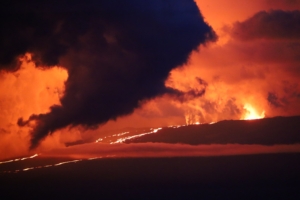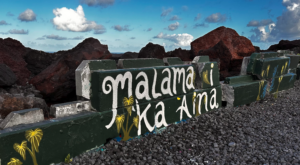Yes, it is possible to take a day trip from Kona to Hawai’i Volcanoes National Park, plan for a long day as the park is located on the eastern side of the Big Island, and Kona is on the western side. Many people fit VNP in midweek as the BIG DAY of driving in between beach and relaxing days. Depending on traffic and road conditions, the drive can take approximately 2.5 to 3 hours one way.
Alternatively, consider staying overnight in the Hilo area or near the national park if you have the flexibility. This would allow you more time to explore the park without the time constraints of a day trip.
Always check for any updates or advisories before embarking on your trip, as conditions and recommendations may change.

You can drive clockwise or counterclockwise around the island. I like to drive counterclockwise so the after-dark driving is through the middle on Saddle Road rather than the winding narrow Hwy 11/Mamalahoa Hwy. Fuel up with a quick breakfast at Kaya’s Coffee in Kealakekua before cruising southeast on Highway 11. The coffee is great and the food is delicious. Just in time for a bathroom break and a malasada, you’ll arrive at the famous Punulu’u Bake Shop.
Be sure to pull over at the picturesque Punalu’u Black Sand Beach, where volcanic sand glistens against the turquoise ocean. There is a very good chance you’ll see some turtles feeding on the rocks or basking in the sun.
Upon arrival at Volcanoes National Park, your exploration begins at the Kilauea Visitor Center. Gather updates on volcanic activity and trail conditions, then embark on a scenic drive along Crater Rim Drive with stops at Steam Vents and Sulphur Banks.
Next, take a walk through the Thurston Lava Tube, a formed lava tunnel offering a glimpse into the heart of a volcano. Refuel with a picnic lunch within the park, enjoying the fresh air and stunning surroundings.
In the afternoon, take a drive down Chain of Craters Road, a mesmerizing journey through volcanic landscapes. Stop at various points of interest, like the Kilauea Iki Overlook, and consider a hike into the Kīlauea Iki Crater. It is a steep beginning and ending but for the experience of walking through a solidified lava lake, it’s worth it.
Check the National Park Service for lava activity. If there is activity it is worth it to stya overnight in the area and come back after dark. Watch molten lava bubbling into the lava lake after sunset. Another sight you will never forget.
If you’re waiting for sunset to see the lava or want to eat before heading back to Kona, The Rim restaurant in Volcano House is a lovely choice. Before you sit down check out views of the crater and park and the cozy chairs by the fireplace.
Remember to check for updates on volcanic activity or road closures before your trip, and pack snacks, lots of water, and sunscreen, as services within the park are limited. Wear comfortable clothing and walking shoes, and don’t forget a light jacket for the cool evening air.
This itinerary is just a suggestion, and you can tailor it to your interests and available time. Whether you’re a seasoned adventurer or a curious first-timer, a day trip to Volcanoes National Park from Kona promises an unforgettable experience filled with volcanic wonders and breathtaking beauty.
So, pack your bags, lace up your shoes, and get ready to embark on an adventure you’ll never forget!
Another stop on the Hilo side is Hawai’i Tropical Botanical Garden. Immerse yourself in the contrasts of the island by going from the lava lake to a tropical forest


